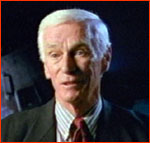
|
 |
 |
Gene Cernan flew on Gemini 9, Apollo 10, and Apollo 17. Of the 12 Apollo astronauts who walked on the moon, Cernan was the last. On Gemini 9: "Notwithstanding the fact that we were moving through or around the Earth or through space at 17,000 miles an hour, everything I touched on the spacecraft ... would touch me back and I would go tumbling back out in space." Here I am, 250 pounds in my spacesuit and all my gear and everything and in zero gravity, it's somewhat of a helpless feeling, quite frankly. And I had now to assemble this backpack, and I had to pull down the arms and twist them and turn on the oxygen, and there were just a myriad of physical, heavy physical work and labor to do and we take for granted gravity. Because we can do that kind of work with ease if something is holding our feet to the ground. Nothing was holding me anywhere. Notwithstanding the fact that we were moving through or around the Earth or through space at 17,000 miles an hour, everything I touched on the spacecraft or twisted or turned or tried to move would touch me back and I would go tumbling back out in space. And finally, I just had to twist the handle and try and keep my body in position with literally the strength of my wrist and my forearms. I did get overheated. We found out the Gemini spacesuit was, well, oxygen was flowing to keep me cool as well as to breathe, and it wasn't good enough. My visor got fogged. In nighttime, I had two little pin lights. One actually didn't work, so I couldn't see very well. My visor was fogged. The sun sets, it's nighttime. I, in fact, had ripped one of the interior insulation layers at the back of my suit. And when I was working during the daytime I could feel the heat of the sun just bear through my suit. It was a real challenge. I was determined, and I finally did get in this astronaut-maneuvering unit. I finally did get it assembled, checked out, strapped in, took off my lifeline, my oxygen umbilical and communications umbilical that lead directly to the spacecraft, and I literally put myself out there on my own. All Tom Stafford had to do was flip a switch, and I would have been out there free to fly around space like we see perhaps in the comic strips of 50 years ago when we talk about Buck Rogers. On Apollo 17: "We just landed on another world somewhere in this universe."
On Apollo 17: "Finding orange soil on the moon was a surprise, and when I heard Jack say that, I knew this geologist had been on the moon too long."
Now, the moon is bland in color. I call it shades of gray. You know, the only color we see is what we bring or the Earth, which is looking down upon us all the time. And to find orange soil on the moon was a surprise, and when I heard Jack say that, I knew this geologist had been on the moon too long. I knew he was running out of oxygen, or it was time to take him home. And I went over there and I said, "Don't move it, don't move it until I see it." Now, I don't know how much he sees, whether he saw an orange rock or what he saw. And sure enough I started over there and I was 10, 15 feet away, and I could see it was orange. The first thing I did was pick up my gold visor, which was a sun visor, to make sure I wasn't seeing something that was being tinted by the visor. And sure enough, I mean, it was orange. It was truly an exciting find. No one knew what it was, whether it was old soil, new soil, soil from oxidized soil, an indication of oxygen or iron ore deep from the inner surface or whatever. It didn't turn out to be what people thought it might be, but it was a major discovery. And that's why you send people. Back to Hear the Space Pioneers Photo: NASA Explore the Moon | Lunar Puzzlers | Last Man on the Moon Hear the Space Pioneers | Origins | Resources Transcript | Site Map | To the Moon Home Editor's Picks | Previous Sites | Join Us/E-mail | TV/Web Schedule About NOVA | Teachers | Site Map | Shop | Jobs | Search | To print PBS Online | NOVA Online | WGBH © | Updated November 2000 |
 Gene Cernan
Gene Cernan